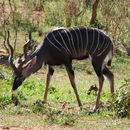en
names in breadcrumbs


Perception Channels: tactile ; chemical
The Lesser Kudu is listed in IUCN as conservation dependent (Nowak 1999). Populations have continued to decline due to hunting or habitat loss caused by human activities or in the case of Tsavo National Park, elephant populations that alter the vegetative landscape.
(Nowak 1999; Walther 1990)
US Federal List: no special status
CITES: no special status
IUCN Red List of Threatened Species: near threatened
N/A
The Lesser Kudu is a hunted game animal, that is used for sport, food, and as a source of money.
Positive Impacts: food ; body parts are source of valuable material
The Lesser Kudu feeds primarily at dusk or at dawn (Roosevelt and Heller 1914) and eats a diverse variety of bush and tree leaves, shoots and twigs, as well as, grasses, herbs, and fruits. It has been reported to be fairly independent of water sources and browses in relatively arid environments.
(Nowak 1999; Roosevelt and Heller 1914; Walther 1990)
The range of Tragelaphus imberbis, the Lesser Kudu, is restricted to northeast Africa. It was once believed to inhabit Saudi Arabia, however, only two sets of horns have been found that substantiate this claim. BR
(Harrison and Bates 1991; Nowak 1999; Roosevelt and Heller 1914; Walther 1990)
Biogeographic Regions: ethiopian (Native )
The Lesser Kudu inhabits dry, flat, and densely thicketed areas, as well as woodlands and hilly land. It is rarely observed in open or cleared areas.
(Nowak 1999; Roosevelt and Heller 1914; Walther 1990)
Terrestrial Biomes: savanna or grassland ; scrub forest
Average lifespan
Status: wild: 10.0 years.
Average lifespan
Status: captivity: 15.0 years.
Average lifespan
Status: wild: 15.0 years.
The Lesser Kudu is the largest bovid in Arabia, with the exception of the Oryx (Harrison and Bates 1991). It is 1.10-1.75 meters from the tip of the snout to the base of the tail and stands at a height of 0.90-1.05 meters. The tail ranges from 0.26 to 0.30 meters with up to 0.90 meters of additional hair length. Males have horns that range from 0.48 to 0.91 meters, have two longitudinal keels, twist 2.5 times, and a basal circumference of 156-171 mm. At the base, they span 6-12 mm; at their ends, they span 0.25-0.35 meters. Males have various shades of grey fur, and females are distinctly more reddish brown. One long white stripe runs the length of the back with 11-14 stripes branching downward off of it. The face has a black stripe from each eye to the nose and a white stripe from each eye to the center of the face. The lip area is white and four white spots are found on the lower jaw (two per side). The legs are fawn colored with a white patch above the hoof. The tail is brown above and white underneath, and a black tip. There are white patches on the throat and chest with a black stripe that spans the chest area. The abdomen is pure white. Young Kudus are similar in color to females but redder, and males become more grey by the age of two years.
The lesser kudu is hard to observe in dry bush due to its camouflage, and because its large ears aid in a well developed sense of hearing that warns it of potential predators.
The skull of the Lesser Kudu is long with a short cranium. The nasal bones are long and narrowed in the center. They form a 'V' shaped suture where they meet the frontals. The supraorbital foramina are located within indentations and are elongated horizontally. The paraoccipital proccess are flat and wide, and the teeth are hypsodont.
(Harrison and Bates 1991; Nowak 1999; Roosevelt and Heller 1914; Walther 1990)
Range mass: 60 to 105 kg.
Other Physical Features: endothermic ; bilateral symmetry
The Lesser Kudu is a fairly solitary species. Young males stay with their mother for only 1.5-2.0 years, before they leave and travel alone or in small sporadic male groups (Nowak 1999). Young females form small groups with their mother or siblings. The Lesser Kudu becomes sexually mature at 1.25-1.50 years, however, males do not gain social status to reproduce until they reach the age of 4-5 years (Walther 1990). BR>Males perform a shoving match, where they press their heads and horns together and attempt to force their horns down onto the nape of their opponent. Males and females also perform a superiority contest, where the male and female stand fully erect on their hind legs and attempt to push each other over. The larger male usually wins. The males show restraint and are never aggressive towards females, though females have been observed to butt their heads against the males. When the males mount, they lay their neck and head down and onto the females back(Walther 1990). <BR>Each female has its own, independent estrus cycle and is anestrus for only a couple of weeks (Nowak 1999). Gestation ranges from 7.5 to 8.0 months, then the female separates from the group in order to give birth. Only one offspring is produced, weighing 4.0-7.5 kg. 50% of the calves die within the first six months, from disease and predation, and only 25% survive to reach 3 years of age. Males begin horn growth after the first 6-9 months and reach full length after 3 years. The life span of the Lesser Kudu reportedly can reach up to 15 years. <BR
(Harrison and Bates 1991; Nowak 1999; Roosevelt and Heller 1914; Walther 1990)
Range number of offspring: 1 (low) .
Average number of offspring: 1.
Range gestation period: 7.4 to 8.5 months.
Key Reproductive Features: gonochoric/gonochoristic/dioecious (sexes separate); sexual
Average birth mass: 6000 g.
Average number of offspring: 1.
Average age at sexual or reproductive maturity (male)
Sex: male: 504 days.
Average age at sexual or reproductive maturity (female)
Sex: female: 504 days.
Parental Investment: altricial ; post-independence association with parents